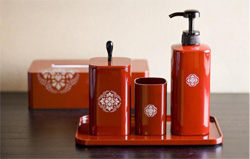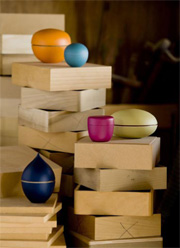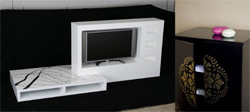Home > Highlighting JAPAN > Highlighting Japan JULY 2011 > All Aizu on Bitowa
Highlighting JAPAN
JAPAN BRAND
All Aizu on Bitowa
In the sleepy historical city of Aizu-Wakamatsu, three hours north of Tokyo by train in Fukushima Prefecture, a small collective is working to combine modern sensibilities with the region's 400-year-old tradition of lacquerware, and help take the craftsmanship of the local artisans to the twenty-first century global marketplace. Gavin Blair reports.

The "BITOWA" line is a series of products decorated with the Bitowa brand crest using the taka-makie style of high-relief lacquer on a base executed by hana-nuri lacquering with grinding, the main characteristic of Aizu lacquerware. Pictured, a cotton box, cup and soap dispenser.
Credit: COURTESY OF BITOWA
Like traditional crafts around the world however, Aizu lacquerware has faced a challenging environment in recent years, with cheap imports and an aging body of artisans threatening its survival. Bitowa was formed in 2005 by a group of younger businesspeople with plans to bring together local craftsmen, broaden the range of products they make, and market them under a common brand.
The Bitowa group partnered with Japan Brand even before it began officially displaying and selling its pieces in 2006.
"We had more than twelve companies in the group at the beginning, but not everyone agreed on the way we were doing things, so now it's settled down to four companies," says Norihiro Endo, managing director of Endo Tadashi Shoten, a lacquerware workshop with a long history in the Aizu-Wakamatsu and one of the Bitowa founding companies.

Bitowa's "Modern" series combines elegant design with a sense of casualness. Products in this series, like the little containers pictured, come in white, turquoise green, magenta, orange, yellow green, and navy.
Credit: COURTESY OF BITOWA
"We've all faced some hard times but we all have a lot of pride in the monodzukuri manufacturing of Aizu and don't want to see it disappear" says Endo.
One Piece, Multiple Talents
What sets apart the way Aizu lacquerware products are made is that each of the elements that make up the pieces is carried out by a different artisan.
"A sowashi makes the flat pieces of wood for boxes or trays, and a kijishi makes bowls and other round pieces. Then an itamono-nurishi applies lacquer to the flat pieces, and a marumono-nurishi does the same for round items. Finally, a makie-shi coats the designs on the surfaces of the pieces," explains Endo.
While maintaining the traditional elements of the region's crafts, the Bitowa group has adapted them to suit contemporary tastes and needs.

The Bitowa "Order" line focuses on furniture such as chests, dressers and TV board, table and stools.
Credit: COURTESY OF BITOWA
"The processes that go into traditional lacquer are so intricate that they end up being very expensive," says Endo. "So we've simplified some of them, such as reducing the number of lacquer layers, in order to create goods that can be used for everyday life, not just decoration."
Nevertheless, even the supposed simplified pieces display the character and craftsmanship that has developed over four centuries in the Aizu Urushi tradition. The wooden canisters used for holding Japanese tealeaves, and the wooden cups from the same range, are striking both in their simplicity and their incredible lightness.
The Bitowa group has already begun selling its goods globally online, and has direct sales channels to Germany, France and China.
"We are planning to test market in London next year and also start exhibiting and selling some of our pieces in Shanghai and Beijing," explains Endo enthusiastically.
Closer to home, where the Bitowa group members' hearts definitely are, a Bitowa café is opening in July in Aizu-Wakamatsu.
"It's going to be in that space there," says Endo, proudly pointing out a shop currently being renovated in the middle of the city. "We are going to use Bitowa items as serving dishes in the café, and put other products on display in Aizu too—we hope to sell some as well. And also put something back into the middle of the community."
The city's other major industry is tourism, due to its impressive castle and samurai history. However, this year many tour groups have cancelled their trips amid radiation fears, simply because Aizu-Wakamatsu is in Fukushima Prefecture. The city is located 100 km inland from the crisis-hit nuclear plant and a range of mountains in-between mean it is apparently unaffected.
"Look, the radiation readings here are lower than they are in Tokyo," says Ichiro Kanke, mayor of Aizu-Wakamatsu, pointing to a Geiger counter on his desk that fluctuated between 0.03 and 0.06 microsiverts an hour as he spoke. "If you check the background radiation readings of certain other major cities abroad, you'll find they're higher than they are here."
© 2009 Cabinet Office, Government of Japan






